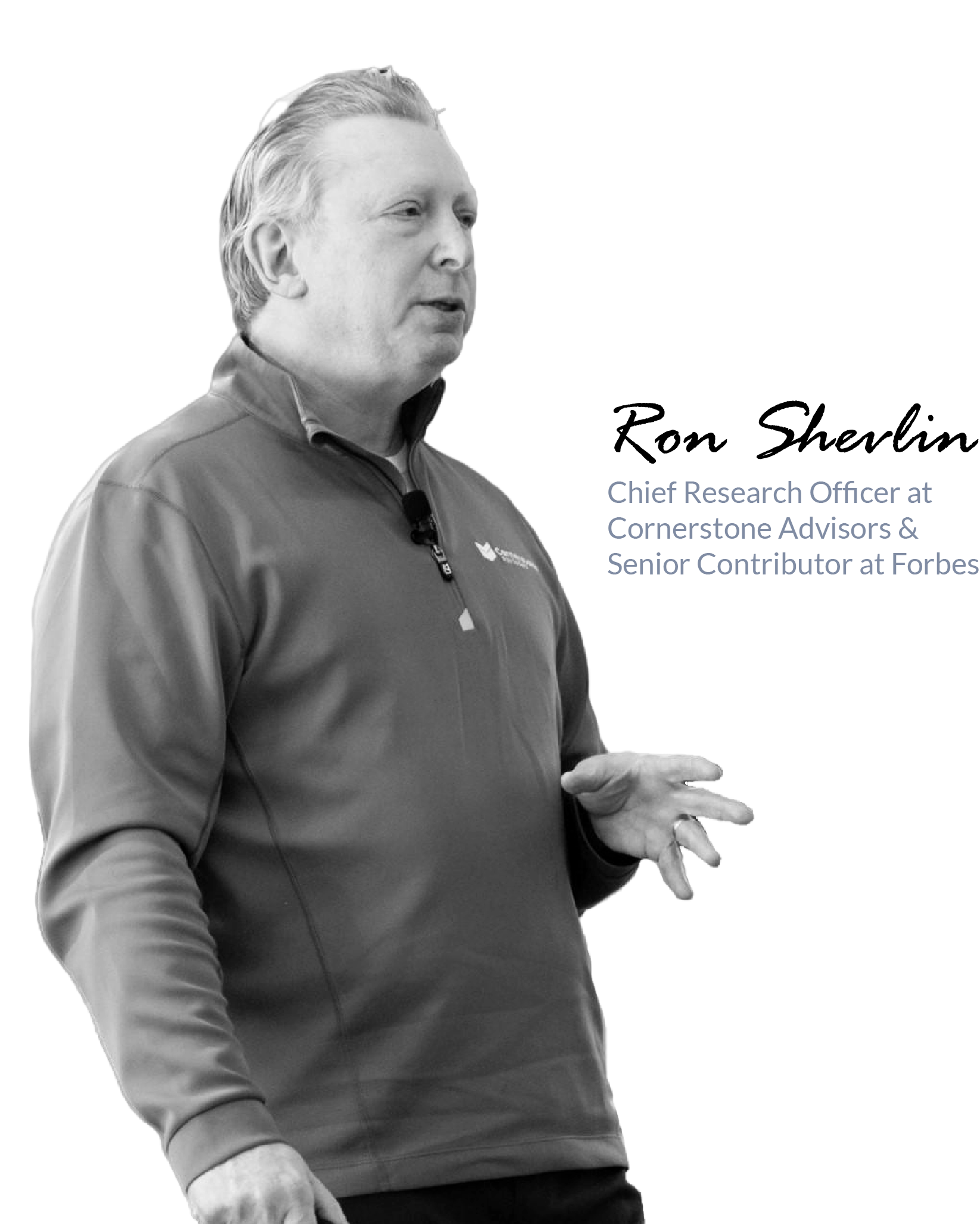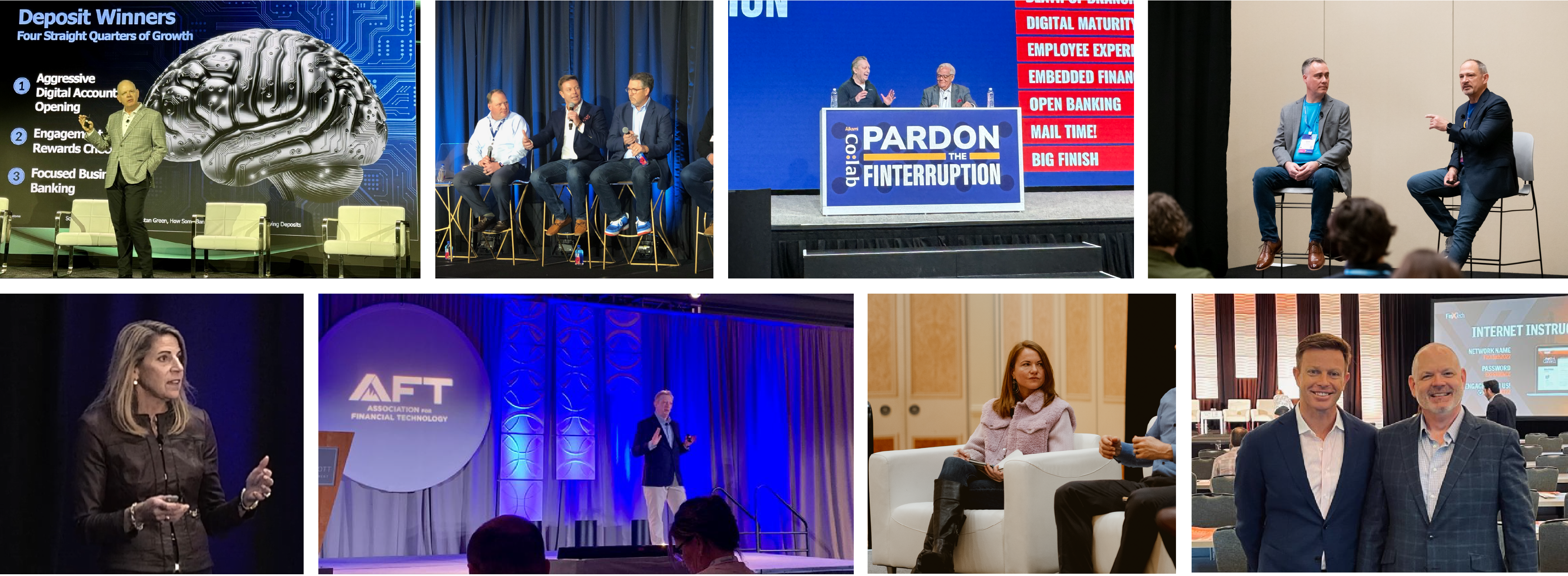Speakers
Thought leaders. Hosts. Panelists. Moderators. Collaborators.

Thought Leadership Backed by Research, Experience and Results
Come for the bluntness. Stay for the intel.
Our team of experts are known for their candor and gritty insights on where the industry is heading and what banks and credit unions are getting right, and just as important, wrong.
Our keynotes and emcee styles are based on our work with hundreds of bank boards and executive teams, our research reports such as What’s Going On in Banking, provocative pieces written for GonzoBanker, and interviews with bank CEOs and fintech founders for our Cornerstone podcasts.
Thought Leadership Backed by Research, Experience & Results
Come for the bluntness. Stay for the intel.
Our team of experts are known for their candor and gritty insights on where the industry is heading and what banks and credit unions are getting right, and just as important, wrong.
Our keynotes and emcee styles are based on our work with hundreds of bank boards and executive teams, our research reports such as What’s Going On in Banking, provocative pieces written for GonzoBanker, and interviews with bank CEOs and fintech founders for our Cornerstone podcasts.


Topics We Discuss
Looking for a speaker or emcee to hire for your next conference, board meeting or pop-up experience?
Browse our team of experts across a range of banking and fintech topics.
Trends
Artificial Intelligence
Blockchain
Consumer Trends
Emerging Technology
Fraud
Industry Trend
Best Practices
Contract Negotiations
Digital Transformation
Payments
Performance
Strategic Planning
Vendor Management
Insights
Bank Risks & Threats
Bank Opportunities
C-Level Opportunities
Finance
Fintech
And More!
Strategies
Bank Strategies
Consumer Market Strategies
Differentiation
Diversification
Go-To-Market Strategies
Growing Value
Featured Cornerstone Speakers
.png?width=300&height=300&name=ron_shevlin_headshot%201(2).png)
Ron Shevlin
Chief Research Officer
Banking and credit union industry trends, research, bank strategy, current financial industry issues
About Ron
Ron Shevlin is the Chief Research Officer at Cornerstone Advisors, where his research on banking and fintech trends helps shape the direction of financial institutions and fintechs. As a technology analyst and consultant for more than 30 years, Ron has conducted hundreds of studies on how consumers and businesses use technology to manage their finances and how technology is changing the future of the financial services industry.
Available For
Keynotes for banking and credit union industry events; panels, webinars, fireside chats.

Al Dominick
Partner
How C-level execs run and protect their business while seeking opportunities to grow and change it. Industry trends tied to diversification and differentiation. Issues that are strategic, risky and expensive
About Al
-
Creator and host of Plugged In, a Cornerstone Advisors’ bank leadership-focused podcast series
-
Frequent keynote speaker and panel moderator, including at Bank of America Security’s Financial Services Conference, nCino’s annual nSight conference and COCC’s annual conference.
-
Former CEO of Bank Director, during which he transformed the Acquire or be Acquired conference into the industry's premier event. Founded, and elevated, FinXTech into a go-to resource.
-
Hosted Looking Ahead, a digital series produced with Nasdaq for corporate executives
-
Regularly quoted in publications like Bloomberg, The American Banker, The Wall Street Journal and other industry-leading publications.
Available For
Keynote conferences, emcee fintech events, moderate C-level panel discussions, present on emerging issues and trends being discussed by officers and directors of financial services companies.
Fun Fact
Four-year varsity baseball player at Washington & Lee… worked with The Economist Group (between NYC and London) on the development of a new company for officers & directors of European companies.

Anne Arvia
Principal
Industry trends, strategic execution, Board governance and achieving top performance
About Anne
Anne Arvia is a strategic financial services leader experienced as a CEO, CFO and a public company board member and audit committee chair, whose unique combination of skills and experience has enabled her to help numerous, diverse businesses be successful. With expertise ranging from business and operational management to distribution and multi-disciplinary models, Anne has made a career of transforming organizations by expertly guiding them to accommodate market shifts. In addition, she has a proven record of effectively attracting top talent and developing high-performing teams.
Available For
Keynote/speak at banking and credit union events, panels, facilitate event session.
Fun Fact
In the spirit of Caitlin Clark’s current impact on evolving the WNBA and her gaining fame at Iowa: Anne played women’s 6 on 6 Women’s Iowa High School Basketball, "back in the day." Although the final game was played in 1993 in a small town in Iowa, the Women’s State tournament rivaled the Men’s State Wrestling in Iowa for fans.

Brandi Gregory
Managing Director
Payments
About Brandi
Brandi Gregory has over 20 years of experience in the financial services industry with an emphasis on relationship management, payments, and contract negotiations.
As a managing director in Cornerstone Advisors’ Contract Negotiation and Payments practices, Brandi leads a team of experts with a collective goal of helping banks and credit unions improve their financial performance through the optimization of their credit and debit card businesses. With her analytical skills and expertise, Brandi shows clients how to take a holistic view of their payments businesses to ensure their vendor partnerships and contracts for both branding and processing are aligned with their strategic long-term goals.
Available For
Keynotes and breakouts for banks and credit union industry events.

Chris Monti
Senior Consultant
Vendor management, digital transformation, total technology transformation, payments and strategic execution
About Chris
Vendor management, digital transformation, total technology transformation, payments and strategic execution
Available For
Credit union and bank events, panels, breakout sessions, fireside chats and targeted research topics.
Fun Fact
When I am not working or learning about various fintech changes, I spend most of my time training and preparing for the upcoming season volunteering as a snowboard patroller separately and tackling the modern day to day issues surrounding the hobby of beekeeping.

Elizabeth Gujral
Senior Consultant
Artificial Intelligence, Fintech and Banking-as-a-Service
About Elizabeth
As a senior consultant with Cornerstone Advisors, Liz splits her time between the firm’s Strategy & Performance team developing growth strategies for banks and credit unions and in Research and Fintech Advisory (RAFA). She has written multiple commissioned research papers and supports the development of go-to-market advisory strategies for fintechs. She is also contributor for Cornerstone Advisor’s alter-ego blog, GonzoBanker.
Available For
Breakout at fintech and banking industry events, panels, bank and credit union board presentations, and webinars.
Fun Fact
Every year Elizabeth travel somewhere new and has visited over 35 countries across four continents. When she’s not trying to scratch her itchy travel feet, she is at home in Arizona with her husband, three cats and dog.

John Meyer
Managing Director
AI, fraud, technology, blockchain
About John
As a managing director with Cornerstone Advisors, John Meyer leads the firm’s Business Intelligence and Data Analytics practice. In this role, he helps community banks and credit unions better use the data they have to make smarter decisions with risks and opportunities.
Available For
Keynotes and breakouts for banking and credit union industry events; panels, webinars, fireside chats.
Fun Fact
The ultimate foodie, John has a sixteen foot BBQ trailer that he uses to host parties of up to 400 with brisket, baby back ribs, pulled pork, and smoked salmon. He makes his own rubs and Rub Number 4 is his signature for ribs.

Mary Wisniewski
Editor-at-Large
Innovation, fintech and consumer trends
About Mary
Mary Wisniewski has covered fintech and digital banking for more than 12 years. Her bylines have appeared in Gonzobanker, American Banker, Bankrate, the Associated Press and more.
She is an editor-at-large at Cornerstone Advisors where she helps shape content strategy and hosts Money isn’t Everything, a biweekly podcast that explores early-stage fintech ideas. She also writes a monthly editor’s note, Finteching with Mary, on LinkedIn.
Available For
Emcee fintech events, moderate live and virtual panels and collab on pop-up events.
Fun Fact
When she isn’t reading bank disclosures or fintech startups’ websites FAQs, she can be found on the dance floor or still in front of a laptop but writing personal essays.

Ryan Rackley
Partner
Achieving top efficiency technology spending, contract road mapping best practices, negotiation best and worst practices, technology and vendor performance management
About Ryan
As a partner at Cornerstone Advisors, Ryan Rackley leads a team of highly specialized technology contract negotiation consultants in the firm’s Contract Negotiation, Mergers & Acquisitions and Payment practices. His more than 20 years in the financial services space have gained him authoritative expertise in vendor solutions sales and architecture. Ryan has personally negotiated more than 500 bank and credit union technology contracts.
Available For
Keynotes for banking and credit union industry events; panels, webinars, fireside chats.
Fun Fact
Ryan is a collegiate golfer, retired 3rd degree blackbelt, competitive swim dad, mountain biker, skier, worst jokes ever

Sam Kilmer
Managing Director
Growing value, winning deals, partnerships, improving go-to-market, learning from mistakes, fintech and banking trends
About Sam
Sam Kilmer leads Cornerstone Advisors’ fintech advisory practice working with industry providers, fintechs, and investors. He also leads select strategy engagements with banks and credit unions.
Sam is a nationally sought-after speaker, industry research author, a regular contributor to Cornerstone's blog, GonzoBanker, and moderator of the Fintech Hustle podcast. He is often quoted in industry publications and serves as a judge for Finovate and BAI Global Innovation awards. He is an active member of the Association for Financial Technology (AFT).
Available For
Keynote or breakout at fintech and banking industry events, panels, webinars, fireside chats.
Fun Fact
Beyond hiking and kayaking, a passionate music lover…..“recovering drummer,” occasional hack guitarist, and vinyl record collector.

Steve Williams
CEO & Founding Partner
Industry trends, strategic execution and achieving top performance
About Steve
-
Steve Williams is a founding partner of Cornerstone Advisors.
-
Cornerstone strategy and performance thought leader who has worked with more than 300 financial institution boards and executive teams
-
Keynote speaker and instructor with ABA, Bank Director, ICBA, Credit Union Executives Society, America’s Credit Unions
-
Creator of GonzoBanker blog and co-host of Cornerstone’s Plugged In podcast
Available For
Keynote banking and credit union events, panels, webinars, fireside chats.
Fun Fact
Steve has three daughters, two stepdaughters, and three female dogs. So, he’s ready with Spice Girls and Taylor Swift quotes when needed.

Terence Roche
Founding Partner
Industry trends, strategic execution, Board governance and achieving top performance
About Terence
A founding partner of Cornerstone Advisors, Terence Roche brings 40 years of experience in bank operations and consulting. He has directly managed over 50 system selection processes and written numerous technology plans.
Terence has directed several organizational assessments and process redesign engagements and has performed assessments of corporate and functional job titles and incentive plans. He frequently works with boards on governance issues.
Available For
Keynotes for banking and credit union industry events; panels, webinars, fireside chats.

Tony DeSanctis
Senior Director
Payments, bank strategy, AI, innovation, fintech, and consumer trends
About Tony
-
25-years as a banking professional who has led Payments, Digital and Operations for multiple large financial institutions.
-
Frequently quoted in industry periodicals including American Banker, Bloomberg, NPR, Financial Brand, Digital Transactions and more.
-
A frequent speaker at industry conferences, including ABA CCB, and State Bank Association Events also on the faculty of Pacific Coast Banking School and Stonier School of Banking at UPenn.
-
Lead the education efforts for Cornerstone including Payments and Digital School as well as Disruption university and our executive roundtables
Available For
Speak or emcee events, moderate panels, host webinars or facilitate education sessions.
Fun Fact
When not reviewing 106 open tabs in Chrome for the latest industry news, Tony enjoys football, a good cigar and spending time with his perfect wife!
Ready to Elevate Your Next Event? Hire a Cornerstone Speaker.
Gritty Insights from Our Speakers & Thought Leaders
Cornerstone Advisors Podcasts

What’s Going On In Banking
What's Going On In Banking brings you the latest insights and commentary from industry leaders breaking news as it happens. Host Ron Shevlin is the Chief Research Officer for Cornerstone Advisors, Forbes Contributor and author of the "What's Going On In Banking" Annual Report.

Money isn’t Everything
Who says banking must only be about the bucks? Hosted by Mary Wisniewski, Money Isn’t Everything is a biweekly show that focuses on the broader view of how banking integrates with and impacts the lives of consumers and businesses. From financial health to the many unexpected places traditional banking is appearing, the show explores the fringes of change in the industry with early-stage startups, academics, journalists and creative fintech thinkers.

Fintech Hustle
Join host Sam Kilmer, fintech advisor, in unscripted conversations with top fintech industry leaders. No planned corporate talking points, no scripts, and no pitches. Just useful advice and insights. To keep it lively, Sam often brings co-hosts like author/researcher Ron Shevlin, former American Banker editor Mary Wisniewski and former Bank Director/FinXtech CEO Al Dominick.

Plugged In
Plugged In brings you a raw, honest take on all things in the banking industry. That means you aren’t going to get some buzzword-filled, cliche podcast – you’re getting an unfiltered look into topics in the financial world no one else is talking about. Your hosts, Al Dominick and Steve Williams will talk to top players in the industry about what matters now and what will shape the future.




